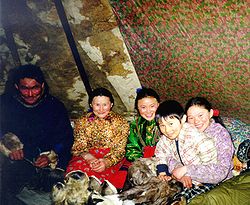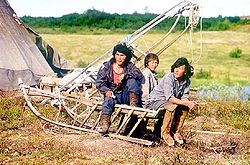- Nenets people
-
Nenets 
Nenets family in their tent. Total population 42,000 Regions with significant populations Russia Languages Religion Predominantly † Orthodox Christianity
(Russian Orthodox Church)
also ShamanismRelated ethnic groups other Samoyedic peoples
The Nenets (Nenets: ненэцяˮ, Russian: ненцы) are an indigenous people in Russia. According to the latest census in 2002, there are 41,302 Nenets in the Russian Federation, most of them living in the Yamalo-Nenets Autonomous Okrug and Nenets Autonomous Okrug. They speak either the Tundra or Forest varieties of Nenets.
Contents
Name
Due to a false etymology,[1] the name Samoyed entered the Russian language as a corruption of the self-reference Saamod, Saamid (the Samoyedic suffix "-d" denotes plurality). It is the same as Saami (formerly Lapps or Lapons) in Finland, and Suomi, the finnish name of Finland. In Russian ethnographic literature of the 19th century, they were also called "Самоядь", "Самодь", (samoyad', samod', samodijtsy, samodijskie narody) which was often transliterated into English as Samodi.
The literal morphs samo and yed in Russian convey the meaning "self-eater", which appears as derogatory. Therefore the name Samoyed quickly went out of usage in the 20th century, and the people bear the name of Nenets, which means "man".
When reading old Russian documents, it is necessary to keep in mind that the term Samoyed' was often applied indiscriminately to different peoples of Northern Siberia who speak related Uralic languages: Nenets, Nganasans, Enets, Selkups (speakers of Samoyedic languages). Currently, the term "Samoyedic peoples" applies to the whole group of different peoples. It is the general term which includes the Nenets, Enets, Selkup, and Nganasan peoples.
Nenets are just a part of the Samoyedic peoples. Sometimes their name is spelled as Nenet because of the erroneous assumption that the terminal 's' is for the plural number.
Language
Main articles: Nenets languages, Tundra Nenets language, and Forest Nenets languageSome 27,000 people speak the language.[2]
History and way of life
There are two distinct groups based on their economy: the Tundra Nenets (living far to the north) and the Khandeyar or Forest Nenets. The third group Kominized Nenets (Yaran people) has emerged as a result of intermarriages between Nenets and the Izhma tribe of the Komi peoples.
The Samoyedic languages form a branch of the Uralic language family. They moved (from farther south in Siberia) to the northernmost part of what later became Russia before the 12th century.
They ended up between the Kanin and Taymyr peninsulas, around the Ob and Yenisey rivers, with only a few of them settling into small communities like Kolva. Their main subsistence comes from hunting and reindeer herding. Using reindeer as a draft animal throughout the year enables to cover great distances. Large-scale reindeer herding emerged in the 18th century. They bred the Samoyed dog to help herd their reindeer and pull their sleds, and European explorers later used those dogs for polar expeditions, because they have adapted so well to the arctic conditions. Tundra wolves can be a source of considerable economic loss, as they prey on the reindeer herds which are the livelihood of some Nenets families.[3] Alongside with reindeer meat, fish is a major component in the Nenets' diet.
They have a shamanistic and animistic belief system which stresses respect for the land and its resources. They had a clan-based social structure. The Nenets shaman is called a Tadibya.
After the Russian Revolution, their culture suffered due to Soviet collectivisation policy. The government of the Soviet Union tried to force the nomadic Samoyeds to become sedentary. They were forced to settle in villages and their children were educated in state boarding schools, which resulted in erosion of their cultural identity. Many, especially in the Nenets Autonomous Okrug lost their mother tongue and became assimilated. Since the 1930s, a few Nenets have come to express themselves through professionalized cultural media. For instance, Tyko Vylka and Konstantin Pankov became well-known painters. Anna Nerkagi is one of the most celebrated Nenets writers. Yuri Vella, though living as a reindeer herder, has become the first writer in the Forest.
Environmental damage is significant due to the industrialisation of their land. Because of the expansive gas and oil industry, the reindeer pastures are shrinking and overgrazing of certain areas in some regions (Yamal Peninsula) have further endangered the Nenets way of life. It has also been documented that climate change is causing problems for nomadic Nenets reindeer herders, as certain parts of the land they need to cross is only accessible in winter - which now comes later and leaves earlier. The Arkhangelsk-based medical doctor Leonid Zubov has documented that this sometimes causes Nenets people to lose access to medical facilities, as they are "stuck" in the wilderness for longer periods of time (waiting for the snow) and have to leave the villages earlier (before the snow melts).[4]
See also
References
- ^ http://education.yahoo.com/reference/dictionary/entry/Samoyed
- ^ Games, Alex (2007), Balderdash & piffle : one sandwich short of a dog's dinner, London: BBC, ISBN 9781846072352
- ^ Heptner, V. G. & Naumov, N., P. (editors) Mammals of the Soviet Union Vol.II Part 1a, SIRENIA AND CARNIVORA (Sea cows; Wolves and Bears), Science Publishers, Inc. USA. 1998. ISBN 1886106819
- ^ Berg-Nordlie, Mikkel: Upcoming Deluge or False Prophecy? Climate Change Debates in the Russian North The NIBR International Blog, 16.06.2011
 This article incorporates text from a publication now in the public domain: Chisholm, Hugh, ed (1911). Encyclopædia Britannica (11th ed.). Cambridge University Press.
This article incorporates text from a publication now in the public domain: Chisholm, Hugh, ed (1911). Encyclopædia Britannica (11th ed.). Cambridge University Press.
External links
- UNESCO Red Book on endangered languages
- Endangered Uralic Peoples
- Jarkko Niemi: The types of the Nenets songs. 1997
- Minority languages of Russia on the Net
- The Red Book of the peoples of the Russian Empire
- Historic-demographic note on the Nenets of the Komi Republic
- BBC: Nenets Tribe
- Photos of Nenets reindeer herders
Finno-Ugric peoples Samoyedic peoples Eastern and Oriental Orthodox Christian Ethnic Groups Majority EuropeanArmenians · Aromanians · Belarusians · Bulgarians · Georgians · Greeks (including Greek Cypriots) · Macedonians · Megleno-Romanians · Moldovans · Montenegrins · Ossetians · Romanians · Russians · Serbs · UkrainiansAfro-AsiaticAltaicUralicChukotko-KamchatkanMinority Categories:- Nenets Autonomous Okrug
- Yamalo-Nenets Autonomous Okrug
- Ethnic groups in Russia
- Eurasian nomads
- Indigenous peoples of Europe
- Indigenous peoples of North Asia
- Samoyedic peoples
- White Sea
- Aboriginal peoples in the Arctic
- Modern nomads
Wikimedia Foundation. 2010.

